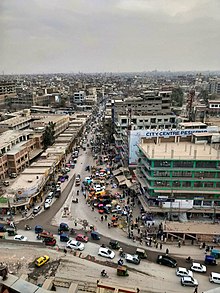Peshawar (District)
| Peshawar District | |
| State : |
|
| Province : | Khyber Pakhtunkhwa |
| Seat : | Peshawar |
| Coordinates : | 34 ° 0 ′ N , 71 ° 45 ′ E |
| Area : | 1 257 km² |
| Residents : | 4,269,079 (2017) |
| Population density : | 3,396 inhabitants per km² |
| Time zone : | PST ( UTC + 5 ) |

|
|
Peshawar District is an administrative district in Pakistan in Khyber Pakhtunkhwa Province . The seat of the district administration is the city of the same name Peshawar .
The district has an area of 1257 km² and according to the 2017 census 4,269,079 inhabitants. The population density is 3396 inhabitants / km².
geography
The district is located in the center of the Khyber Pakhtunkhwa Province, which is in the north of Pakistan.
history
Peshawar is located in a geostrategically important place and has a rich history. The district and the city at its center have seen the rise and fall of many civilizations. It was once the center of the Gandhara civilization and was later ruled by Persians, Greeks, Buddhists, Cushans, Afghans, Mughals, Sikhs and British.
Demographics
Between 1998 and 2017, the population grew by 3.99% annually. About 46% of the population live in urban areas and about 54% in rural areas. 2,201,257 men, 2,067,591 women and 231 transgender people live in 489,843 households , which results in a gender ratio of 106.5 men per 100 women, which is a common surplus for Pakistan.
The literacy rate in the years 2014/15 among the population over 10 years of age was 62% (women: 42%, men: 78%) and thus above the average for the province of Khyber Pakhtunkhwa of 53%.
| year | population |
|---|---|
| 1972 | 807.012 |
| 1981 | 1,113,303 |
| 1998 | 2,026,851 |
| 2017 | 4,269,079 |
Web links
Individual evidence
- ↑ a b DISTRICT WISE CENSUS RESULTS CENSUS 2017. August 29, 2017, accessed May 30, 2019 .
- ↑ Pakistani Districts wise Population Census 2017. Accessed May 30, 2019 .
- ^ Pakistan Bureau of Statistics (2016). Pakistan Social and Living Standards Measurement Survey 2014-15. Government of Pakistan, accessed June 29, 2019 .

